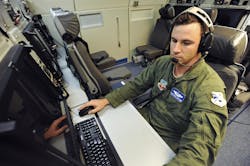Boeing to equip E-3 AWACS avionics with high-speed internet SATCOM capability in $50 million contract
HANSCOM AIR FORCE BASE, Mass. – Military avionics experts at the Boeing Co. will equip U.S. Air Force AWACS radar surveillance and military air traffic control aircraft with high-speed internet capability under terms of a $50 million sole-source contract announced Monday.
Officials of the Air Force Life Cycle Management Center at Hanscom Air Force Base, Mass., are asking the Boeing Defense, Space & Security segment in Oklahoma City to continue the Airborne Warning and Control System (AWACS) Internet Protocol Enabled Communication (IPEC) program.
The AWACS IPEC project, which is part of the Air Force AWACS Modernization and Sustainment Support initiative (AMASS), provides a permanent Inmarsat-based, IP-enabled communication package high-bandwidth Secret Internet Protocol Router Network (SIPRNet) and multidomain networks.
IPEC is part of continuing upgrades to the Boeing E-3G AWACS Block 40/45 to provide permanent satellite-based internet protocol communications over high bandwidth classified and multi-domain networks.
Related: Boeing to upgrade computers, IFF, navigation, and communications aboard Saudi AWACS planes
Messaging connectivity to E-3G aircraft provides chat, air tasking order, airspace control order, email with attachments, and website download capability simultaneously.
IPEC kits consist of wiring harnesses, bundles, and connectors; as well as about line-replaceable units with Inmarsat SATCOM equipment, communications security (COMSEC), and networking equipment. Boeing handles the IPEC installations at Tinker Air Force Base in Oklahoma City.
The Air Force operates 31 AWACS aircraft -- 27 of them at Tinker Air Force Base, Okla.; and four based at Kadena Air Base, Japan, and at Elmendorf Air Force Base, Alaska.
NATO, meanwhile, operates 17 AWACS. The United Kingdom has seven, France has four, Saudi Arabia has five, and Japan has five. Japan's AWACS are based on the Boeing 767 jetliner.
The U.S. AWACS, based on the four-engine Boeing 707 single-aisle jetliner, offers command and control, battle management, surveillance, target detection, and tracking. The AWACS watches airspace from the Earth's surface up into the stratosphere, over land or water.
The AWACS mission suite includes consoles that display computer-processed data in graphic and tabular format on video screens. Mission crew members perform surveillance, identification, weapons control, battle management and communications functions.
On this contract Boeing will do the work at Tinker Air Force Base, Okla., and should be finished by August 2026. For more information contact Boeing Defense, Space & Security online at www.boeing.com/company/about-bds, or the Air Force Life Cycle Management Center at www.aflcmc.af.mil.

John Keller | Editor-in-Chief
John Keller is the Editor-in-Chief, Military & Aerospace Electronics Magazine--provides extensive coverage and analysis of enabling electronics and optoelectronic technologies in military, space and commercial aviation applications. John has been a member of the Military & Aerospace Electronics staff since 1989 and chief editor since 1995.


